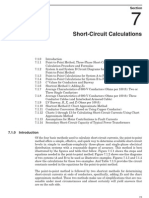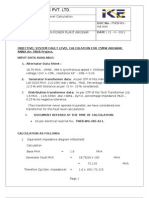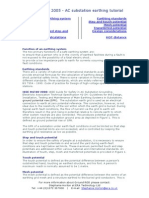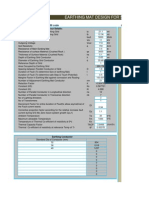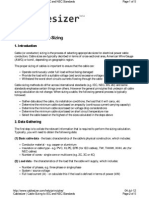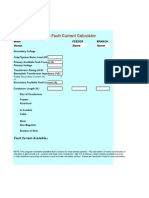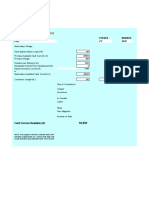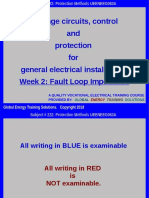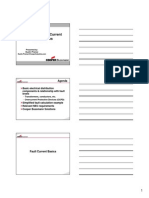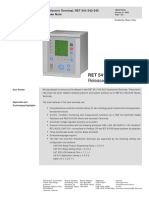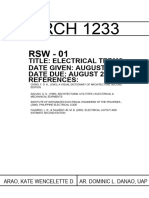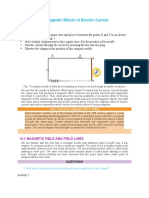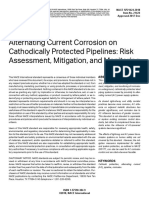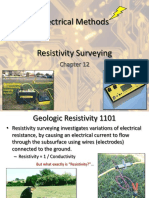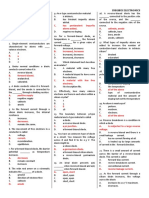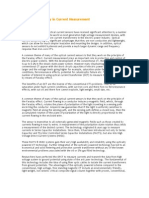Contractor Fault Current Guide
Uploaded by
rasim_m1146Contractor Fault Current Guide
Uploaded by
rasim_m1146Building Permit Series
Fault Current Calculation Form
Please Print or Type Legibly
FOR CITY USE ONLY
Project Name:
Date Stamp
Permit Number(s):
Site Address:
Suite Number(s):
Contractor or Property Owner Name:
Address:
Phone:
City:
State:
Zip:
Cell:
Use the following instructions to complete the fault calculation form on the following page. This form
shall be completed and submitted prior to service approval; continue with these steps until each panel has
been addressed or the fault current is below the minimum equipment rating.
INSTRUCTIONS
Step 1:
To calculate the Secondary Transformer (I.C. rating) at its rated voltage, calculate ohms as
follows:
Transformer ohms =
Y (defined in Step 3 or Step 4, below)
Short Circuit Amps
120/240V
208Y / 120V
240V Delta
480Y / 277V
480V Delta
Step 2:
Conductor Impedance =
1 ohm 3-wire
3 ohm 4-wire
3 ohm 4-wire
3 ohm 4-wire
3 ohm 3-wire
120
102
140
277
277
(Impedance per 1000 ft.) x Conductor Length
1000 x Number of Parallel Runs
Step 3:
Y = Service I.C. (C2) x Total ohms (transformer ohms + cable ohms)
Step 4:
Y = Subpanel I.C. (E2) x Total ohms (transformer ohms + cable ohms)
NOTE
Transformer replacements which result in a higher possible fault current than that of the existing
equipment shall be reviewed by this department prior to reconnection of existing service equipment.
4114 198TH St SW, Suite 7 | PO Box 5008 | Lynnwood, WA 98046-5008 | Phone: 425-670-5400 | Fax: 425-670-6534 | www.ci.lynnwood.wa.us
-1-
Building Permit Series
Fault Current Calculation Form
Value
Total
Impedance
Fault Current
A. UTILITY TRANSFORMER
1. Rated Capacity
KVA
2. Secondary Voltage
Volts
3. Nameplate % Impedance OR
4. Transformer Short Circuit Amps
Amps
5. Ohmic Impedance (Y)
Step 1:
Ohms
Ohms
B. SERVICE CONDUCTORS
(Type CU or AL)
1. Conductor Size
2. Conductor Length
ft.
3. Type of Conduit
4. Impedance/1000 ft.* (ohms/1000)
Ohms
5. Number of Parallel Runs
6. Conductor Impedance **
Step 2:
Ohms
7. Total Impedance to Source (A5 + B6)
Ohms
8. Fault Current at Load Terminals (Y/B7)
Step 3:
Amps
C. SERVICE ENTRANCE EQUIPMENT
1. Service Rating
Amps
2. Interrupting Rating
AIC
D. FEEDER CONDUCTOR
1. Conductor Size
2. Conductor Length
ft.
3. Type of Conduit
4. Impedance/1000 ft.* (ohms/1000)
Ohms
5. Number of Parallel Runs
6. Conductor Impedance **
Step 2:
Ohms
7. Total Impedance to Source (B7 + D6)
Ohms
8. Fault Current at Load Terminals (Y/D7)
Step 4:
Amps
E. FEEDER PANEL
1. Equipment Rating
Amps
2. Interrupting Rating
AIC
* Contact Snohomish County PUD for cable impedance information.
4114 198TH St SW, Suite 7 | PO Box 5008 | Lynnwood, WA 98046-5008 | Phone: 425-670-5400 | Fax: 425-670-6534 | www.ci.lynnwood.wa.us
-2-
Building Permit Series
Fault Current Calculation Form
** (Impedance per 1000 ft x conductor length) divided by (Number of Parallel Runs x 1000)
4114 198TH St SW, Suite 7 | PO Box 5008 | Lynnwood, WA 98046-5008 | Phone: 425-670-5400 | Fax: 425-670-6534 | www.ci.lynnwood.wa.us
-3-

